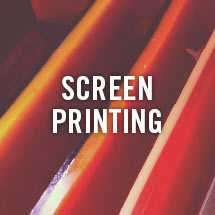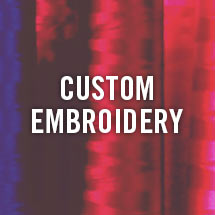Printed T-shirts have been a wardrobe staple for decades, but the art of printed clothing has been around much longer. Here’s a brief timeline of the iconic graphic tee and how it became both a marketing tool and a stylish cultural symbol.
The Backstory
The earliest record of screen-printing dates to the Song Dynasty in China (between 960 and 1279 AD). This method consisted of gluing a piece of silk between two pieces of thick paper. Paint was then able to seep through the silk area and print a design.
Although this practice was perfected throughout most of Asia during the Middle Ages, screen printing didn’t become popular in Europe until the 1900s when a man named Samuel Simon patented the method. A group of artists in New York continued to experiment with the method, founding the Serigraphy Society, originally called the Silk Screen Group, which focused on the artistic application of T-shirt printing.

The Rise of the Basic Tee
Where did the classic fit T-shirt get its start?
Long before printed T-shirts, these classic garments were designed for their utility. In the late 19th century, T-shirts were sold as practical undergarments mostly worn by factory workers and military personnel. They were both durable and breathable, making them an ideal choice for wearing on the job. They were typically made of cotton or wool and did not feature any decoration or design – yet.

T-Shirt, Meet Slogan
The “peanut butter meets chocolate” moment for printed T-shirts didn’t happen until World War II when U.S. soldiers began wearing T-shirts as more decorative outerwear. This trend eventually trickled down to civilians and the iconic graphic tee was born.
This trend was fueled through the following decades by counterculture, political slogans, music festival culture and many more political and social movements. T-shirts became a way to get your message out there, express creativity and create art.

Screen Printing in Advertising
Fast forward to the early 1960s in Miami. Several resorts in the area began printing their names and promotional characters onto T-shirts as a form of advertisement. Shortly thereafter, the ringer T-shirt, which featured a solid shirt with contrasting collar and sleeve bands, came onto the scene. Tie-dyed and other printed shirts became wildly popular. Popular printed designs included swirling multi-colored designs, happy faces and the iconic I heart NY.
New Trends, New Technology
During the 1960s, the demand for printed T-shirts continued to grow. Around the same time, the rotary multicolor garment screen printing machine was developed and quickly became the most popular method for printing designs. The machine made it much easier to mass-produce designs and keep up with the demand. These machines are still frequently used today.

The development of Platisol ink was another game changer for the industry. Up until the 1960s, water-based ink was the only option for printing t-shirts. The new Plastisol ink consists of two main ingredients: a white powder called PVS resin and a clear liquid called plasticizer. This ink requires high temperatures (Think: 300-330 degrees Fahrenheit) to cure, or dry, similar to the dye sublimation method.

Changing Times, Changing Trends
The popularity of T-shirts continued to grow as the art form evolved and styles changed. In the 1970s, brands such as Coca Cola and Disney began to use T-shirts to advertise their brands, a trend that continues today. In the early 2000s, funny T-shirt slogans became all the rage (Think: I’m With Stupid.) Shirts that made a political statement or represented a charitable cause also became widely used.
Although printed T-shirts have evolved over time, one thing has stayed the same: their universal popularity and staying power. When BBC asked popular British designer Katharine Hamnet her opinion on the future of the industry, she answered that she believed T-shirts would live on forever. “I don’t think you can take them away … [they’re] unbeatable.”
The Best Material for Printed T-Shirts
Because every screen-printing project is different, there’s no such thing as one-size fits all when it comes to choosing the perfect material for printed T-shirts.
100% Cotton
Tried and true, cotton is one of the most popular T-shirt materials, and with good reason. This soft, comfortable material can be printed with just about any kind of ink or design. It’s hypoallergenic, which means it won’t irritate those with sensitive skin.
In the past, 100 percent cotton T-shirts were infamous for being thick and heavy. These days, with updated technology, they can be produced with a lightweight, breathable feel.
One of cotton’s biggest selling points is its affordability. Cotton T-shirts are relatively inexpensive to produce, which makes this material a great option for large-scale or budget-conscious projects.
Cotton fabric, while comfortable, isn’t quite as light as other fabrics. And, it doesn’t dry quickly. Cotton material is best for tees that aren’t specifically meant to be worn outside or while exercising.
100% Polyester
If you’re creating shirts for people on the move, polyester might be your best bet. This T-shirt material is more durable than cotton, which makes it less likely to shrink or stretch. It’s also lightweight.
Polyester fabric dries quickly, which is why it’s often called “moisture wicking.” It’s also more resistant to odors and stains than cotton. If your audience is going to be out in the hot sun, spending time near the water or working up a sweat, they’ll be much more comfortable in a polyester T-shirt.
The increased durability of polyester comes with a slightly higher price point, so it might not be the best option for those trying to cut costs.
Cotton/Polyester Blend
What did Hannah Montana call it… the best of both worlds? A cotton-polyester blend offers some of the benefits (and drawbacks) of both T-shirt materials already discussed.
Cotton/polyester blend is more durable than cotton alone but isn’t quite as expensive to produce as a shirt that’s 100 percent polyester. The look, feel and durability of your T-shirt will depend on the percentage of each material that makes up your blend.
Some blended fabrics also have rayon added to the mix. Many people call this combination of cotton, polyester and rayon “tri-blend” material. The versatility of blended fabrics makes them another popular choice for all kinds of T-shirts.

Branding with Custom Apparel
Today, printed T-shirts are a core part of marketing for many organizations, including:
- Businesses
- Schools
- Sports Teams
- Non-Profits
Affordable and accessible, T-shirts can help get your name out there and tell your story. They build reputation, raise awareness and create customer loyalty. From logos to slogans and brand colors, designing the perfect T-shirt for a company, group or event can have a massive return on investment.
Be Part of the Movement
Want to stay up to date with the newest and best trends in screen printing, custom apparel and promotional items? Our team at Full Press Apparel can help guide you through popular items and how to incorporate them into your budget. From small projects to big orders, we’re backed by decades of experience and commitment to getting it just right. Call (850) 222-1003 or send us a message today to discuss your big dreams and how we can make it happen.





